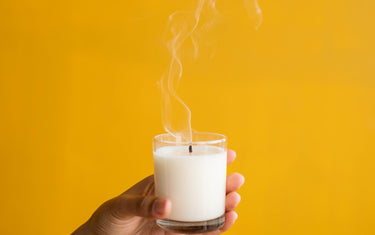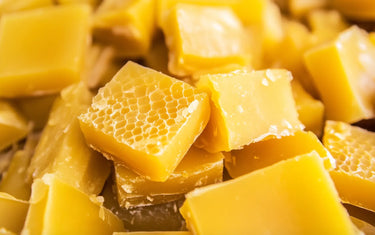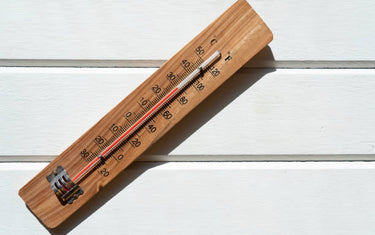5 min read / 11 April 2023 / Laura Garvin Gomez
How to Make Mosquito Repellent Candles
Learn how to make your own effective mosquito repellent candles with our simple guide using natural ingredients and essential oils.

Spring is in the air, which means longer, warmer days and blooming of nature everywhere you look.
But it also means more bugs and insects are buzzing around with the likes of mosquitos and other pests, causing an unwanted nuisance.
Rather than spraying and swotting them to death, there are other natural and more kinder ways to keep them at bay. Citronella candles could be the thing you are looking for, and we explain all about them below.
What are citronella candles?Citronella candles are candles that are made from citronella oil. The oil is extracted from the citronella plant before being distilled into oil form and has been used for decades to repel mosquitos and other flying insects. It works as a natural, organic alternative to chemical repellents, so you can ward off bugs without having to kill them. |
How do insect repellent candles work?
Flying insects can be a real pain during the warmer months of the year – although they probably detest us as much as we do them.
Using an insect killing spray doesn’t feel fair, especially as they are simply sharing the same space, and the chemicals found in these types of products can also be harmful to our own health.
Outdoor citronella candles offer a simple and effective alternative that can be used in external spaces. When included in a candle recipe, the oil evaporates into the air once the candle has been lit, helping to mask the human scents that attract mosquitos and other insects.
Citronella candles produce a floral, citrus-like aroma that works as a deterrent to trick insects and bugs whilst also being a pleasant aroma that adds to the outdoor ambience.

How to make citronella candles
To make citronella candles for flies and other insects, follow the steps below:
- Choose your candle container: Make sure this is a heat-proof container made for use in candle making. The larger the container, the more wax flakes you will need.
- Support the wick: Use a glue dot to tape the wick to the bottom of the container. Use a couple of pencils or chopsticks resting on the lip of the container on both sides of the wick to keep it upright during the pouring stage.
- Measure the wax: Max melts to half its volume so bear this in mind when measuring how much you need. Also account for leaving 1-2 inches at the top of the container to stop the wax from overflowing. Ensure the wick is about 1-2 inches below the rim to protect the flame outdoors.
- Melt the wax: Fill a large pan to the halfway point and place on a hob. Place the wax into a heatproof glass bowl or smaller pan and place inside to create a ban-marie. Warm over a medium heat until the wax melts.
- Add the citronella: Remove the smaller pan/glass bowl from the water and leave it to cool for 5 minutes. Then add in the citronella oil (3 drops per 250ml should be fine) and slowly mix.
- Pour the wax: Carefully add the melted wax to your chosen container, keeping a close eye that the wick remains centred. The wax will immediately start to harden and can take 3-4 hours.
- Trim the wicks: Trim the wick to around ¼ inch above the wax before you light it so the flame can continue to burn.
It is a good idea to let the candles cure for at least 48 hours before you start to burn them. When lighting for the first time, let the whole surface melt to the edges before you blow it out, as this helps it to burn evenly.

What is the best citronella oil to use for mosquito candles?
Citronella oil is an essential ingredient that is needed for candles to repel mosquitos and other bugs. Our citronella essential oil is incredibly versatile as it can be used to ward off insects and it also has anti-inflammatory properties that can help to relieve cramps and soothe sore muscles. The scent is also popular for its ability to relax and calm overactive, restless minds, whilst also finding use as a key ingredient in organic homemade cleaning sprays.
What alternatives are there to citronella candles?
- Lemongrass works as a powerful insect repellent: If you would like an alternative to using a citronella candle there are other options, with lemongrass often proving to be one of the most popular. The two plants share a lot of similarities, so it makes sense to combine the oils to enhance its repelling properties and wonderful aroma. Lemongrass essential oil can also be used to benefit gut health and applied topically to improve the condition of your skin.
- Lavender, lemon and citronella offer a delightful blend: Our insect repellent essential oil blend is a wonderful mix of citronella, lavender and lemon, giving you another natural way to keep insects away from your home. The blend contains lavender 40/42 oil that is stronger and more consistent compared to most other varieties, adding to the already powerful scent of citronella. The sharp, zesty scent offered by the lemon essential oil provides the perfect counterbalance and the finishing touch that should help you to remain bug free.
- Try a combination of essential oils: You could go one step further by trying a combination of four essential oils, such as those found in our bug repellent essential oil blend. In addition to citronella, lemongrass and lavender the blend also contains peppermint, which is well known for its insect repelling abilities. Mix this with water or a carrier oil to make your own homemade bug spray or add to an oil burner so bugs will always know where they are not welcome.

Dealing with bugs and insects is an inescapable part of spring and summer, so it helps to have some easy ways to keep them away. Using a natural citronella candle or organic homemade bug spray recipe is not only better for the environment but also for our bodies in the long run. They are inexpensive to make and can be highly effective, allowing you to relax in the warmer weather without too many bugs getting in the way of your enjoyment.










